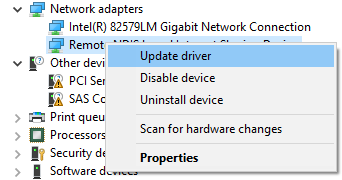Then it will ask you the device type, go down select Network Adapters. Select microsoft as manufacturer and select Microsoft Corporation. Then, select Remote NDIS based Internet Sharing Device. Hit next, it will say it's not safe, etc etc, proceed to install it. Download USB Remote NDIS Device for Windows to net driver. Initially, it says 'MiFi 6620L' then converts to 'Remote NDIS based Internet Sharing Device' driver. Things appear to be going well until the yellow exclamation point pops up and Windows alerts you that the driver installation failed. When reviewing the driver in Device Manager, the driver details indicate 'The driver could not start. Now you will have two options: - Remote NDIS based Internet Sharing Device - Remote NDIS Compatible Device I chose the second one and it solved the problem, but if it doesn't work you could try the other one. In my case, the driver that was being used was neither of these, but a special driver from Android SDK ADT bundle.
- Remote Ndis Based Internet Sharing Device #2 Driver Downloads
- Remote Ndis Based Internet Sharing Device #2 Driver Download Windows 10
- Remote NDIS Based Internet Sharing Device #2 Driver Download
Remote Ndis Based Internet Sharing Device #2 Driver Downloads
Summary :
If the traditional ways to enable the network connection on Windows are available, you can use USB Tethering instead. MiniTool Software shows you how to set up USB Tethering and how to troubleshoot USB Tethering on Windows 10 in this post.
What Is USB Tethering?

USB Tethering allows you to share your phone’s mobile data with other Wifi-enabled devices including the laptop. Then other devices can surf the internet. Tethering is similar to Wi-Fi Tethering. It will be useful if you don’t have other ways to connect the internet.
Do you really understand USB Tethering? If you don’t understand, let’s change another way to make an explanation. Usually, you use the network cable or Wi-Fi adapter to connect your laptop to the internet. But, if you can’t access the network connection using these two ways, you can USB Tethering instead to allow the network connection. Unlike Wi-Fi tethering, USB Tethering works through the USB connection.

You can consider USB Tethering as an Ethernet connection. But, it is much faster than Wifi tethering and even Bluetooth tethering.
Usually, USB Tethering is free unless your carrier has blocked it. If you are sure it is allowed by your carrier, you still need to set up USB Tethering on Windows.
In this post, we will show you how to set up USB Tethering on Windows 10.
USB port not working? No matter you are using Windows 10/8/7 or Mac, you can read this article to find a proper solution to fix this issue.
How to Set up USB Tethering on Windows 10
Remote Ndis Based Internet Sharing Device #2 Driver Download Windows 10
The way to make such a setup is quite simple. You can follow these steps:
- Connect your phone to your PC with a USB cable.
- If your phone asks you to enable the File Transfer feature on the screen, you need to cancel it.
- When you see the prompt like Tethering or Hotspot active - Tap to set up on your phone screen, just tap the option to continue. But, if you don’t see this prompt, you need to go to Settings > Network and Internet > Hotspot and tethering to manually enable USB Tethering.
A new network adapter will be created in Windows 10 and your computer will use it to connect to the internet. When you access Network settings on your computer, you need to make sure that the Wi-Fi feature is disabled on your phone. Otherwise, USB Tethering will be disabled if your phone is connected to an existing network.
Here, you need to know that the exact location of USB Tethering may be different on different brands of phones. But, it is always clubbed with the Mobile and Data Network section.
Do you know how to fix the Android file transfer not working or responding issue? In this post, we collect some solutions that are proved to be effective.
If USB Tethering Is Not Working on Windows 10
Some Simple Things You Can Do if USB Tethering Is Not Working
Remote NDIS Based Internet Sharing Device #2 Driver Download
Windows 10 is using the Remote NDIS based Internet Sharing Device network adapter to enable USB Tethering on Windows 10. If your USB Tethering is not working suddenly, you can do these things:
- Check whether the Wi-Fi connection is connected automatically. If so, disable it.
- Check whether the USB cable is disconnected.
- Check whether the USB Tethering is accidentally turned off.
Update NDIS Driver
If USB Tethering is still not working after these basic checks, you can enter Device Manager to update the NDIS driver to have a try.
- Press Win + X + M at the same time to open Device Manager.
- Unfold Network adapter.
- Right-click Remote NDIS Compatible Device and select Update driver.
Then, you can go to check whether there is an available update. If yes, you can follow the guide to update it. If there is not, you need to manually view and locate the USB RNDIS6 Adapter and upgrade it.
At last, reboot your computer to see whether USB Tethering can work normally.
We hope this post can help you set up USB Tethering on Windows 10 and solve the USB Tethering not working issue when necessary.